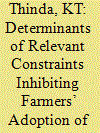|
|
|
Sort Order |
|
|
|
Items / Page
|
|
|
|
|
|
|
| Srl | Item |
| 1 |
ID:
179112


|
|
|
|
|
| Summary/Abstract |
The adverse effects of climate change on agricultural productivity are on the increase. This study employed both descriptive statistics and the multivariate probit model to estimate factors constraining the adoption of climate change adaptation strategies among smallholder farmers in the study area. The empirical results of the multivariate probit model showed that a lack of knowledge of climate change constraints was influenced by smallholder farmers’ age, gender, off-farm activity, susceptibility and membership in farmer-based organizations. Thus, to improve the adaptive capacity of farmers, government and development partners should work together to improve the conditions under which farmers can gain access to climate change information and suitable agricultural credit as well as policy incentives aimed at lowering the stringent conditions of borrowing in the agricultural sector.
|
|
|
|
|
|
|
|
|
|
|
|
|
|
|
|
| 2 |
ID:
156761


|
|
|
|
|
| Summary/Abstract |
Coastal Bangladesh is highly vulnerable to climate change and salinisation; hence, farm-level adaptation is critically important. Farmers' perceptions of and responses to environmental change were investigated in two villages in Khulna District. Perceived environmental trends included increases in temperature, extreme weather events, soil toxicity, erratic rainfall and scarcity of water for irrigation. Perceptions of climate trends were consistent with measured trends in Khulna. On-farm adaptation strategies included adjusting planting dates, excavating trenches in rice-fields, adopting new crops, salinity-reducing technologies, livestock-rearing and home-yard cropping. Non-farm adaptation strategies included wage employment, short-term migration and self-employment. Adaptation was facilitated by income-earning opportunities, training, and credit, and impeded by lack of access to water, markets, capital, and extension services. Farmers suggested policy support for dissemination of stress-tolerant cultivars, access to irrigation, and price stabilisation or crop insurance to assist adaptation. While the study shows an impressive degree of awareness and adaptation, external support is needed to increase adaptive capacity.
|
|
|
|
|
|
|
|
|
|
|
|
|
|
|
|
|
|
|
|
|